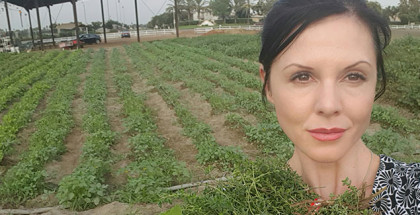California Farmers Face Challenges in Wake of Trump Administration Deportation Policy
April 3, 2017 | Charli Engelhorn
The 2004 film A Day Without a Mexican presented a scenario in which fresh produce from California’s farms were being sold on the black market and out of car trunks as a consequence of the sudden disappearance of the country’s Mexican population. Although satirical in nature, the message behind the film is becoming more relevant due to recent Trump administration policies regarding immigration and deportation.
According to statistics from the Farm Labor Survey of the USDA’s National Agriculture Statistics Service, in 2012, there were nearly 1.1 million farm workers, on average, working on the 2.1 million farms in the United States. Of those workers, approximately 50 percent were undocumented laborers. This percentage increased when broken down into specific crop production, with undocumented workers accounting for 67 percent of farm workers in the fruit and nut industry and 61 percent in the vegetable industry compared to nine percent and 17 percent, respectively, of farm workers who were U.S. citizens.
“With half the workers not fully or properly documented to work, raids can reduce available workers,” said Daniel Sumner, director of the University of California Agricultural Issues Center and Frank H. Buck, Jr. professor in the Department of Agricultural and Resource Economics at the University of California, Davis. “The problem is worse the closer to a major period of peak labor use, such as harvesting or pruning.”
California is home to 77,900 of the 2.1 million farms in the United States and accounted for $47 billion in income from farm outputs in 2015, according to the California Department of Food and Agriculture 2015 Crop Report. This number, although substantial, is a 17 percent decrease from the reported income from 2014. If undocumented workers continue to be moved out of the state at high rates, this number could continue to decrease, as the ability of California’s farms to export crops overseas and domestically becomes impeded.
California’s top farm commodities include almonds, asparagus, peppers, grapes, dairy, walnuts, pistachios, strawberries, raspberries, blackberries, lettuce, tomatoes, and oranges. Some of these commodities, such as almonds and dairy, have technology that assists in the harvesting and manufacturing of goods, which eases some of the labor burden. However, many crops, such as peppers, asparagus, cherries, and berry varieties, require human labor for precision and proper selection and to avoid damaging vulnerable crops.
The relationship between undocumented labor and farm production poses the obvious problems for farmers and employees, but those problems also stretch into the pockets of U.S. citizens. This issue lies mostly in the cost of labor.
As farm labor is strenuous and sometimes dangerous — such as spending hours on tall ladders to glean fruit — workers tend to move on after a few years to better-paying, less intense positions. Since many Americans will not work these types of positions, enforcement against undocumented workers leaves farmers with labor shortages, swaths of abandoned crops, and the need to increase wages to attract new workers.
With California farmers already experiencing a labor shortage caused by reduced numbers of migrant workers from previous immigration policies, prices for labor have increased by 36 percent over the last decade, according to an article on Bloomberg.com. These higher wage prices translate to more money spent for smaller yields and the need to make up for the loss in income.
What this scenario boils down to is reduced options for farmers and a likely significant negative impact for consumers both in the United States and abroad.
Estimates by the American Farm Bureau Federation (AFBF) suggest that in 2012, the farm labor shortage was responsible for $3.3 billion in missed GDP growth and $1.3 billion in farm income that could have been earned. The report further stated that America would have added 89,000 more jobs that year if farmers had been able to maintain their market share of produce during the previous decade.
“With fewer workers available, wages will rise and farms will shift to less labor intensive methods and crops,” says Sumner. “In general, this would raise retail prices a little for certain labor intensive crops, such as strawberries or fresh tree fruits, such as peaches, that are harvested by hand.”
Yet, this retail price increase is suggested by other sources to be more significant and affect more than mere labor-intensive crops. The AFBF study from 2014 projects that consumers could see up to a five-to-six percent increase in food prices, and a 2015 study conducted by Texas A&M researchers for the National Milk Producers Federation suggests that milk prices could increase by 45.2 percent percent if even half of the 80,000 undocumented workers in the dairy industry are lost.
Such increases in costs to consumers could drive them to more affordable imported goods, causing farmers to lose even more of the market share. Likewise, if prices increase in the United States, export prices could be less competitive, causing other countries to back out on trade agreements or rely on more reasonable domestic products. In California, 20–26 percent of farming output is exported to Mexico, Japan, Canada, and the EU, to name a few.
California farmers are becoming concerned about what increased labor costs and shortages could mean for their income, according to Sumner, which is understandable with the threat of losing crops, market share, and export relationships a reality if the extent of Trump’s deportation policy is realized.
“Farmers and workers are concerned but hopeful that some accommodation will be made for workers current employed,” says Sumner.











Submit a Comment